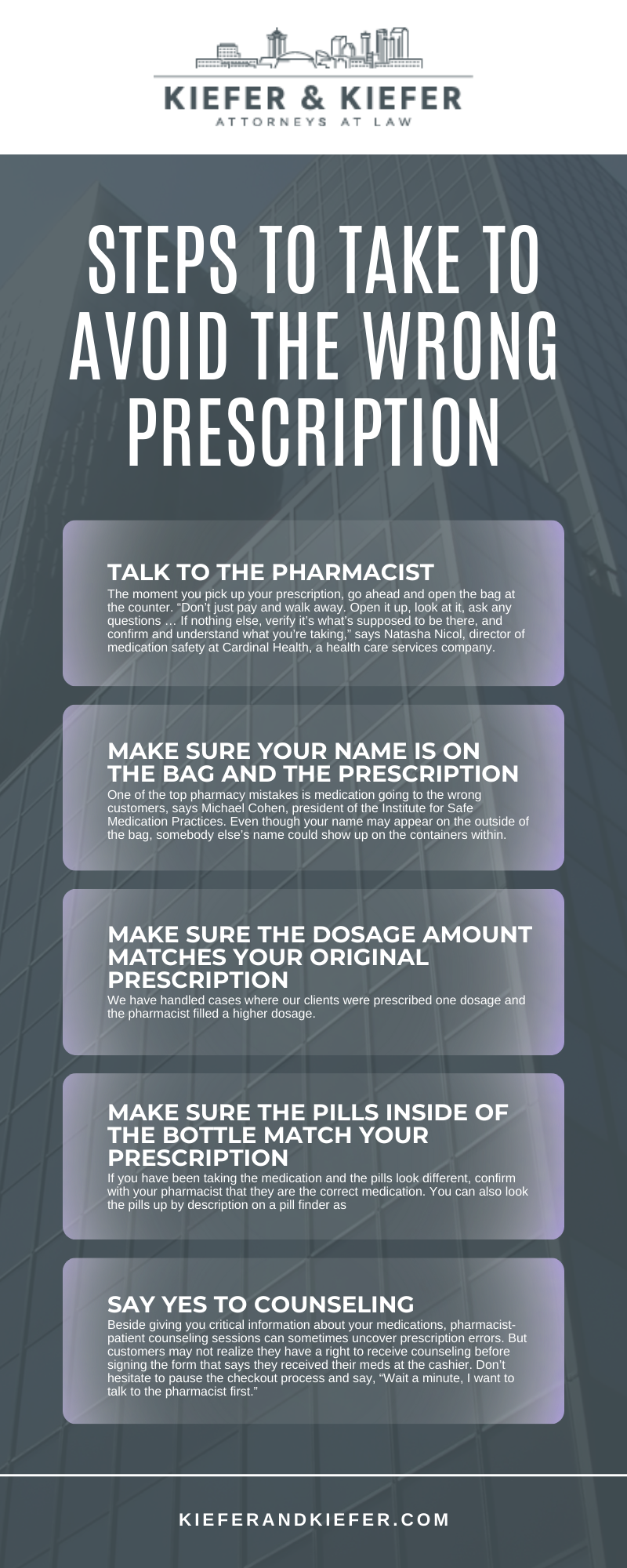It is estimated that in 2019, 4.25 billion retail prescriptions will be filled throughout the United States in 2019. Often times, the patient notices the pharmacy had given a wrong prescription and never takes it.
Other times, the patient may take the incorrect medication and it be harmless. In some unfortunate cases, patients unknowingly take the wrong prescription and it can cause severe damages, even death.
If you have been provided the wrong prescription from your pharmacy and suffered injuries, you may be able to sue your pharmacist for filing the prescription incorrectly.
How often does a Pharmacy fill the wrong prescription?
An estimated 30 to 50 million prescriptions are filled incorrectly each year, said Allen Vaida of the Institute for Safe Medication Practices, an organization that independently monitors pharmacy errors nationwide. That’s about 2 percent of all the over 4 billion prescriptions filled annually.
According to Gerald Gianutsos, an associate professor of pharmacology at the University of Connecticut School of Pharmacy, a prescription label with incorrect directions is the most frequent type of prescription error, but, occasionally, a patient will also receive either the wrong dosage of the correct medication or the wrong medication altogether.
Many drugs have names that sound similar and that use similar spellings, and when they’re arranged alphabetically on the pharmacy shelf, “it’s very easy to grab the wrong one by mistake and look at it real quick … and think that you’re dispensing the right drug,” Gianutsos says.
What Happens in Cases Where the Pharmacy Gives the Wrong Prescription?
Often times, the filling of a wrong prescription is harmless. At other times, however, it can be very tragic. For example, the two suits below highlight how serious pharmacy errors can be.
In 2015, a Louisiana jury returned a verdict of $1,000,000 against Walgreens. In that case, the Plaintiff, who suffers from high blood pressure and diabetes, was given another customer’s prescription of Zyprexa, a potent anti-psychotic medication. Unfortunately, due to the fact that she was not taking her blood pressure medication, she suffered a stroke and sustained disabling injuries, including left-sided neural deficits and paralysis as a result of the stroke. The jury found Walgreens to be primarily responsible for her injuries.
In 2017 in Illinois, a Plaintiff filed a wrongful death claim against Walgreens claiming that Walgreens failed to instruct her on the proper administration of a prescription resulting in the death of her son. She claimed she and her mother, who was also caring for the boy, were told by both Walgreens employees and the label the employees placed on the medication that tacrolimus was to be kept refrigerated. Additionally, she claims that she questioned the directions and informed the staff that previous tacrolimus prescriptions had come with warnings not to refrigerate it, but that the staff “carelessly and negligently rebuked and misled” her and her mother.
How can I Protect Myself from Getting the Wrong from Getting the Wrong Prescription from my Pharmacy?
While there is no 100% certain way to protect you from another person’s negligence, there are some steps you can take to try to avoid taking the wrong prescription even if the pharmacy gives you the wrong prescription.
- Talk to the Pharmacist. The moment you pick up your prescription, go ahead and open the bag at the counter. “Don’t just pay and walk away. Open it up, look at it, ask any questions … If nothing else, verify it’s what’s supposed to be there, and confirm and understand what you’re taking,” says Natasha Nicol, director of medication safety at Cardinal Health, a health care services company.
- Make sure your name is on the bag and the prescription. One of the top pharmacy mistakes is medication going to the wrong customers, says Michael Cohen, president of the Institute for Safe Medication Practices. Even though your name may appear on the outside of the bag, somebody else’s name could show up on the containers within.
- Make sure the dosage amount matches your original prescription. We have handled cases where our clients were prescribed one dosage and the pharmacist filled a higher dosage.
- Make sure the pills inside of the bottle match your prescription. If you have been taking the medication and the pills look different, confirm with your pharmacist that they are the correct medication. You can also look the pills up by description on a pill finder as an added layer of protection.
- Say yes to counseling. Beside giving you critical information about your medications, pharmacist-patient counseling sessions can sometimes uncover prescription errors. But customers may not realize they have a right to receive counseling before signing the form that says they received their meds at the cashier. Don’t hesitate to pause the checkout process and say, “Wait a minute, I want to talk to the pharmacist first.”
Can I sue the pharmacy if they gave me the wrong prescription Infographic
 What Do I do if I think my Pharmacist Gave me the Wrong Prescription?
What Do I do if I think my Pharmacist Gave me the Wrong Prescription?
If you think that your pharmacy gave you the incorrect prescription, make sure you do the following:
- Call the doctor who prescribed you the medication immediately;
- Seek emergency medical attention;
- Call the pharmacy to report the error;
- If the pharmacy offers you compensation, do not accept it until you consult an attorney about whether the offer is fair;
- Take photographs of the incorrect prescription bottle;
- Do not throw away the incorrect prescription bottle;
- Contact a personal injury attorney to explore your rights;If you think you have suffered injuries due to the pharmacy filing your prescription all a personal injury attorney to discuss whether or not you have a claim against your pharmacy.
– Megan C. Kiefer is a partner and trial lawyer at Kiefer & Kiefer, who specializes in personal injury law.
This is being provided for informational purposes only and not for the purpose of providing legal advice.

 What Do I do if I think my Pharmacist Gave me the Wrong Prescription?
What Do I do if I think my Pharmacist Gave me the Wrong Prescription?